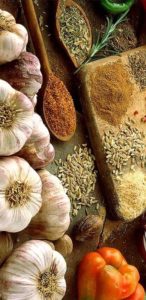From our list of herbs and spices, the following are recommended for Heart Disease:
Scroll down for links.
- Aloe Vera Leaf
- Artichoke
- Astragalus Root
- Black Cohosh
- Blessed Thistle
- Blue Green Algae
- Bromelain
- Bugleweed
- Butchers Broom
- Cayenne
- Celery Seed
- Cocoa
- Cordyceps Mushroom
- Dandelion Root
- Evening Primrose
- Fenugreek
- Flaxseed
- Garlic
- Gentian
- Ginger Root
- Goldenseal Root
- Gotu Kola
- Grapeseed
- Graviola
- Green Tea
- Gum Guggul
- Hawthorn Leaf
- Kelp
- Khella
- Korean Ginseng
- Maitake Mushroom
- Milk Thistle
- Oat Straw
- Olive Leaf
- Omega-3 Fatty Acids
- Parsley Leaf
- Passion Flower
- Peppermint Leaf
- Psyllium
- Quercetin
- Red Wine Extract
- Skull Cap
- Soy
- Uva Ursi
- Valerian Root
Natural Cures and Remedies for Heart Disease
In January 2002 researchers reported in the journal Circulation that repeated infections greatly increased a person’s risk of dying from coronary artery disease. Literally, the more infections people experienced, the more likely they were to develop and die from heart disease. It wasn’t that the bacteria and viruses were directly infecting the heart. More likely, repeated infections maintained a heightened activity of immune cells, which unleashed part of their damage on blood vessel walls.

Contraindications, Interactions, and Side Effects (Licorice) – Class 2b, 2c, 2d. “Contraindicated in heart disease, diabetics, hypertensives, hepatoses, and nephroses” (O’Brien, 1998). Commission E reports contraindications: cholestatic liver diseases, liver cirrhosis, hypertension, hypokalemia, severe renal insufficiency, and pregnancy. May potentiate thiazide diuretics, stimulant laxatives, cardiac glycosides, and cortisol (AHP; WAM). Too much (>50 g/day) can raise the blood pressure, cause sodium and water retention, and lower potassium levels too far. May result in pseudoaldosterianism. Adverse effects reported in M30: amenorrhea, cardiac arrest, congestive
Aloe Vera Leaf, Artichoke, Astragalus Root, Black Cohosh, Blessed Thistle, Blue Green Algae, Bromelain, Bugleweed, Butchers Broom, Cayenne, Celery Seed, Cocoa, Cordyceps Mushroom, Dandelion Root, Evening Primrose, Fenugreek, Flaxseed, Garlic, Gentian, Ginger Root, Goldenseal Root, Gotu Kola, Grapeseed, Graviola, Green Tea, Gum Guggul, Hawthorn Leaf, Kelp, Khella, Korean Ginseng, Maitake Mushroom, Milk Thistle, Oat Straw, Olive Leaf, Omega-3 Fatty Acids, Parsley Leaf, Passion Flower, Peppermint Leaf, Psyllium, Quercetin, Red Wine Extract, Skull Cap, Soy, Uva Ursi, Valerian Root
This asana helps in the treatment of arthirits, rheumatism and low backache. The whole body is strengthened by this asana especially the waist, chest, back and neck. Persons suffering from high blood pressure or heart disease should not practice this asana.
Contraindications, Interactions, and Side Effects (Kava) – Class 2b, 2c, 2d. Contraindicated for endogenous depression (AHP). Maximum tolerated doses for dogs was 60 mg/kg, for rats 320 mg/kg StX (70% kavapyrones). Perversely, if the authors didn’t misspeak, the dogs tolerated 24 mg/kg/day. Of >4000 patients taking 105 mg/day StX (70% kavapyrones), 1.5% had objectionable side effects (allergy, dizziness, GI distress, and headache). At levels 100 times the therapeutic dose (roughly 13 liters kava beverage a day or 300-400 mg rhizome per week) caused anorexia, ataxia, dyspnea, hair loss, red eyes, skin rash, visual problems, and yellow skin. “There is no potential for physical or psychological dependency. Use should not exceed 3 months.” (AHP) Germans limit use to 1-3 months (AHP). Commission E reports contraindications: esophageal and gastrointestinal stenoses; adverse effects: allergic reactions (rarely). Other sources report intestinal obstruction (AEH). Many reports suggest a yellowing of the skin in chronic users. “Chronic ingestion may lead to kawism’ characterized by dry, flaking, discolored skin, and reddened eyes” ( LRNP, May 1987). Persistent rumors suggest that overdoses can cause intoxication. Commission E warns against the concomitant use of kava with barbituates, antidepressant medications, and CNS agents. Lactating or pregnant women should not use kava (WAM). “Not permitted as a non-medicinal ingredient in oral use products in Canada” (Michols, 1995). Abuse by Australian Aborigines suggest links to hematuria, infectious disease, neurological abnormalities, pulmonary hypotension, nephrosis, visual disturbances, ischemic heart disease, thrombosis, and sudden heart attacks (MAB). The following quote might scare abusers, as it should, “Full consciousness is maintained with even fatal doses” (APA, quoting Weiss, 1988).
The basic causes of heart diseases are wrong dietary habits, faulty style of living and various stresses. The famous Framingham Heart Study of the National Heart and Lung Institute identified seven major risk factors in coronary heart disease. These are : (i) elevated blood levels of cholesterol, triglycerides and other fatty substances ( ii) elevated blood pressure (iii) elevated blood uric acid levels (mainly caused by high protein diet), (iv) certain metabolic disorders, notably diabetes, (v) obesity, (vi) smoking, and (vii) lack of physical exercise. Each or a combination of these risk factors can contribute to heart disease. Most of them are of dietary origin. These risk factors can be controlled by changing one’s life style and readjusting the diet.
Aloe Vera Leaf
Artichoke
Astragalus Root
Black Cohosh
Blessed Thistle
Blue Green Algae
Bromelain
Bugleweed
Butchers Broom
Cayenne
Celery Seed
Cocoa
Cordyceps Mushroom
Dandelion Root
Evening Primrose
Fenugreek
Flaxseed
Garlic
Gentian
Ginger Root
Goldenseal Root
Gotu Kola
Grapeseed
Graviola
Green Tea
Gum Guggul
Hawthorn Leaf
Kelp
Khella
Korean Ginseng
Maitake Mushroom
Milk Thistle
Oat Straw
Olive Leaf
Omega-3 Fatty Acids
Parsley Leaf
Passion Flower
Peppermint Leaf
Psyllium
Quercetin
Red Wine Extract
Skull Cap
Soy
Uva Ursi
Valerian Root
that very modest chronic increases in blood sugar, even when in the normal range, significantly increase the risk of developing diabetes or heart disease within just a few years. Both diseases have inflammatory undercurrents, and elevations in blood sugar spontaneously generate free radicals, which can stimulate inflammation.
